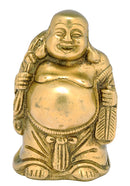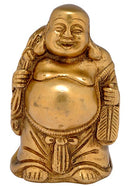Hotei (literally meaning Calico Bag Arhat) is better known in the English-speaking world as the fat Laughing Buddha. Hotei is the interpretation of the Bodhisattva Maitreya, the predicted Buddha to succeed Gautama Buddha in the future. He has become incorporated into Buddhist and Shinto culture and is based on an eccentric Chinese Chan monk. Hotei persists in Japanese folklore as one of the Seven Lucky Gods (Shichi Fukujin).
The Laughing Buddha derives from the time of Sakyamuni Buddha, where there was a monk named Angida, whose name also meant calico bag. Angida was one of the original eighteen Arhats of Buddhism. According to legend, Angida was a talented Indian snake catcher. He used to catch venomous snakes to prevent them from biting passers-by. Due to his kindness, he was able to attain bodhi. Both Hotei and Angida have similar resemblences, as they both are obese, seen laughing and carrying a bag.
The image of Hotei is shown carrying a cloth or linen sack, which never empties, and is filled with many precious items. Sometimes it can be filled with children, as they are seen as some of those precious items of this world. His duty is patron of the weak, poor and children. In some scenes he may be found sitting on a cart drawn by boys, or wielding a fan called an oogi (said to be a "wish giving" fan -- in the distant past, this type of fan was used by the aristocracy to indicate to vassals that their requests would be granted).
The brass figure depicts a stout, smiling or laughing shaved man in robes with a largely exposed potbelly stomach that symbolizes happiness, good luck, and plenitude. The stomach is also considered the seat of the soul in Chinese mythology and so the large stomach can be taken as an allegory for Hotei's Open Heartedness. Some sculptures have small children at his feet. Another item that is usually seen with the Hotei figure, is a begging bowl; to represent his Buddhist nature. All of these images display Hotei as a wandering monk who goes around and takes the sadness from people of this world, in some ways parallel to the Christian Jesus. He most certainly is a loving and cheerful character, strikingly similar to Santa Claus in the West, and is a common statuette found in homes and businesses in China and Japan.
Description
Hotei (literally meaning Calico Bag Arhat) is better known in the English-speaking world as the fat Laughing Buddha. Hotei is the interpretation of the Bodhisattva Maitreya, the predicted Buddha to succeed Gautama Buddha in the future. He has become incorporated into Buddhist and Shinto culture and is based on an eccentric Chinese Chan monk. Hotei persists in Japanese folklore as one of the Seven Lucky Gods (Shichi Fukujin).
The Laughing Buddha derives from the time of Sakyamuni Buddha, where there was a monk named Angida, whose name also meant calico bag. Angida was one of the original eighteen Arhats of Buddhism. According to legend, Angida was a talented Indian snake catcher. He used to catch venomous snakes to prevent them from biting passers-by. Due to his kindness, he was able to attain bodhi. Both Hotei and Angida have similar resemblences, as they both are obese, seen laughing and carrying a bag.
The image of Hotei is shown carrying a cloth or linen sack, which never empties, and is filled with many precious items. Sometimes it can be filled with children, as they are seen as some of those precious items of this world. His duty is patron of the weak, poor and children. In some scenes he may be found sitting on a cart drawn by boys, or wielding a fan called an oogi (said to be a "wish giving" fan -- in the distant past, this type of fan was used by the aristocracy to indicate to vassals that their requests would be granted).
The brass figure depicts a stout, smiling or laughing shaved man in robes with a largely exposed potbelly stomach that symbolizes happiness, good luck, and plenitude. The stomach is also considered the seat of the soul in Chinese mythology and so the large stomach can be taken as an allegory for Hotei's Open Heartedness. Some sculptures have small children at his feet. Another item that is usually seen with the Hotei figure, is a begging bowl; to represent his Buddhist nature. All of these images display Hotei as a wandering monk who goes around and takes the sadness from people of this world, in some ways parallel to the Christian Jesus. He most certainly is a loving and cheerful character, strikingly similar to Santa Claus in the West, and is a common statuette found in homes and businesses in China and Japan.
Payment & Security
Your payment information is processed securely. We do not store credit card details nor have access to your credit card information.




